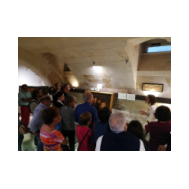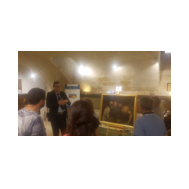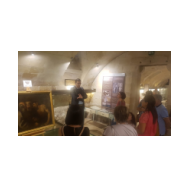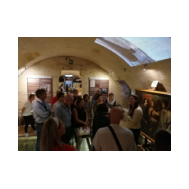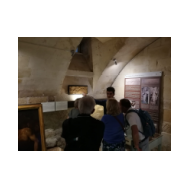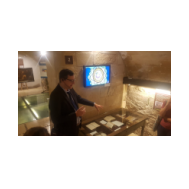DREAMING IN THE BIBLE: A TEXTUAL AND VISUAL ITINERARY
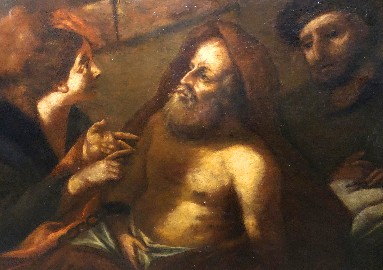
On the Day of Jewish Culture and in conjunction with the exhibition of Emanuele Luzzati’s graphic works Life is a fairy tale, inaugurated last June, the Jewish Museum Lecce organizes an exhibition of texts and paintings dating from the 16th to the 19th centuries. This initiative, which emphasizes the role of the Bible and its versions for the cultural evolution of modern Italy, was originated from the theme chosen this year for the European Day of Jewish Culture: the dream.
The works on display are the result of a widespread study through public and private collections of Salento. The museum itinerary highlights the fact that the direct traces of Jewish culture, which played an extremely significant role in the area until the beginning of the 16th century, had totally disappeared. The removal of this essential part of the local society at the end of the Middle Ages, after the expulsion of Jewish communities from Southern Italy in the mid-sixteenth century, almost ironically coincided with the Renaissance and the strong interest of Christianity in the Jewish culture.
The Catholic Church welcomed the study of the languages of the Scripture within colleges and seminaries also to counter the spirit of the Reformation, which founded many of its ideas on a philological reading of the Bible. Religious congregations and scholars added to their collections printed copies of biblical texts published in various languages.
On display, there are printed works and a small but suggestive selection of biblical paintings, kindly granted by the collector Luciano Treggiari from Lecce.
Dreaming in the Bible – a Textual and Visual Itinerary
A dream opens the philosophical dialogue Sèfer ha-Kuzari (The Book of the Khazar), the most celebrated work of the great Medieval Iberian thinker and poet Judah ha-Lewi (1140-1190 ca.). The king who gives the title to the treatise - originally composed in Arabic - repeatedly dreams of an angel who reveals him his next religious conversion.
Since ancient times, in the Jewish tradition, communication between God and man takes place through dreams. When asleep, the soul releases its imagination – as medieval Aristotelian thinkers explain – and it receives messages from above that the rational faculty would not understood in waking state. This physiological explanation results from the merging of Greek-Hellenistic thought with in the Jewish tradition of angelic mediators. The masters of Rabbinic literature teach that nothing happens to man that is not revealed to him earlier in dream and that a life without dreams is not worth living. The Talmudic treatise Berakhot (Blessings), a treasure trove of interpretations of dreams, records a wonderful prayer recited during the priestly blessing. Here is the beginning: “Lord of the universe, I am Yours and Yours are my dreams...” (Berakhot 55b).
From the earliest drafting stages of the Bible, angels are divine messengers – perhaps originally supernatural numinous phenomena – that communicate future events. Their function is similar to that of the dream. Therefore, it is not surprising that in narrative sections of the Hebrew Bible many episodes present angels that suddenly appear, arousing dismay and trepidation – the fascinum of divinity – and foretelling unexpected situations that upset the natural order of things, as in the case of the three angels who appear to Abraham at the Oaks of Mamre (Gen. 18:1-15). The episode seems to be a dream: the three messengers appear from nowhere and their triple voice soon becomes the only voice of the Lord.
The vision of angels is associated to dream in the well-known episode of patriarch Jacob who realizes the presence of God in the place where he fell asleep. Angels appears in his dream going up and down a ladder, connecting earth and heaven, human world and divine world. However, even in the case of Jacob, the angelic harmonies immediately became a single divine voice (Gen. 28,12-13). The multiplicity is made unity, as well as the stones that the patriarch placed under his head before falling asleep become a single stone when he wakes up (see the original Hebrew Gen. 28:11; 28:18). An angel is the mysterious being that Jacob fights at night, trying to obtain recognition of his mission as founder of the tribes of Israel (Gen. 32:23-33). Thanks to dreams, Jacob discovers the meaning of God’s presence into his life and perceives its special protection (Gen. 31:10-11).
Our exhibition starts from Jacob’s dream, not by chance: the only Jewish inscription preserved in Lecce from the Middle Ages, although mutilated, contains the Hebrew words of the patriarch at his awakening: “En ze ki im bet El[ohim]”, “This is none other but the house of God” (Gen. 28:17). It is a 15th century stone carved with elegant Hebrew characters: it probably decorated the main hall of a synagogue in Lecce, perhaps the one that was converted into a church at the end of the 15th century and was incorporated into the building that currently houses the Jewish Museum. It seems appropriate to underline this surprising coincidence between the text of the epigraph, walled in the basement of Palazzo Adorno, not far from the Museum, and the central theme of the European Day of Jewish Culture 2019.
Although Jacob’s dream had a great importance in the history of Israel and in the Christian reading of the Hebrew text, the interpreters of the Scriptures appreciated dreams starting – above all – from the story of one of the ancient patriarch’s sons, Joseph, “dreamer par excellence” (Gen. 37:19), “interpreter of mysteries” (Gen. 41:45). The Hebrew term halom, “dream”, recurs more than twenty times through the large narrative section that concludes the book of Genesis (Capp. 37-45). Yet in Joseph’s history, the divine intervention does not point out God’s election. From a young age, the future of Jacob’s beloved son is revealed through dreamlike visions that cause dramatic action, as in any fairy tale or novel. Dreams arouse the envy of Jacob’s brothers and their will to take revenge against their younger brother. Because of dreams, the main character is taken prisoner to Egypt where – again thanks to his undisputed oneiromantic skills – he acquires high esteem in an upper class context first, then in prison (Gen. 39, 20-21) and finally in the eyes of the Pharaoh himself, who elevates him to the highest ranks of the kingdom. Joseph’s stories – endowed with such a fairy-tale flavor – are almost certainly a late editorial product; perhaps written from ancient legends or folklore traditions, they show a strong affinity with Hellenistic literary themes.
Like the Greek oracles and rituals in Egypt and Babylon, in the final section of the Book of Genesis dreams are symbolic, unlike the angelic revelations disclosed to other patriarchs, in which the future is explicitly presented. Similar to the “exotic” setting of Joseph, is that of the Book of Daniel, the last work of the whole biblical corpus. The prophet is a young dreamer and interpreter of dreams that reveal to him the redemptive action of God in history (Dan. 2:24; 4:16; 7:1). Thus, the Book of Esther, set in a Babylonian-Persian background, opens with Mordecai’s premonitory dream and closes with the deciphering of the initial message (Est. 1; 10). However, dream and its conclusive interpretation are transmitted only by the Greek version of the Bible and they are not present in the Jewish one.
It seems important that even in the New Testament God’s manifestations to man recur through the intervention of angelic mediators or dreams. In particular, the dream as a means of revelation recurs in the first chapters and at the end of Matthew’s Gospel. God reveals himself – through the usual angelic mediation – in dream to another Joseph, concerning the conception of Jesus, the flight to Egypt, the return from Egypt and the choice to live in Nazareth, Galilee (Matt. 1:20;24; 2:12;19:22). Perhaps it was not by chance that Jesus, son of Joseph (ben Yosef, according to Jewish messianic tradition) moved to Egypt following a dream, like the ancient patriarch son of Jacob, homonymous of the putative father of Jesus.
Fabrizio Lelli


